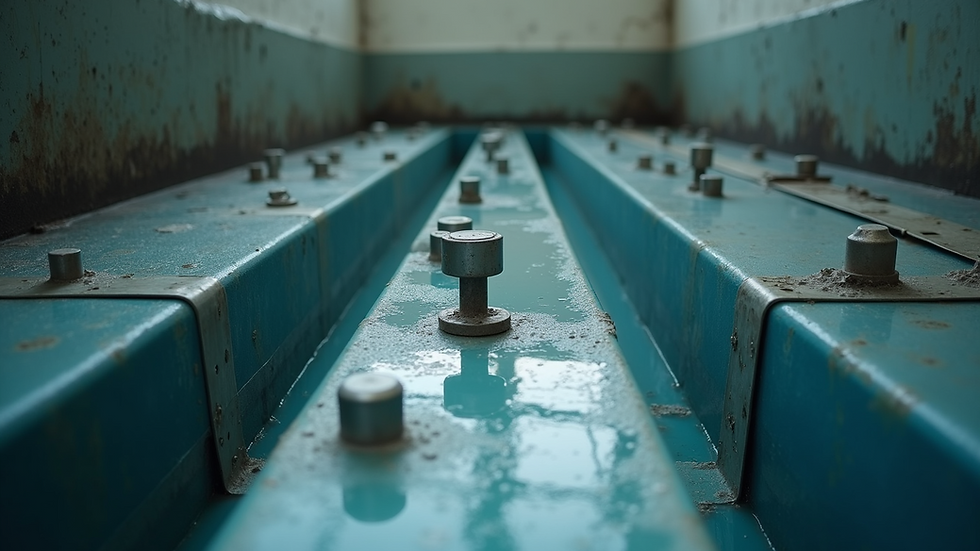Applications of Manganese Phosphate Coatings
- Connie Mareino
- Sep 29
- 4 min read
Manganese phosphate coatings are a critical solution in industries where metal components face extreme wear and corrosion. These coatings provide a durable, wear-resistant surface that extends the life of parts exposed to harsh environments. Their applications span military, aerospace, diesel, nuclear, and heavy equipment sectors, where reliability and performance are non-negotiable. In this article, I will explore the key applications of manganese phosphate coatings, emphasizing their phosphate wear resistance properties and practical benefits.
Understanding Phosphate Wear Resistance in Industrial Applications
Phosphate wear resistance is essential for components subjected to friction, abrasion, and corrosive conditions. Manganese phosphate coatings create a crystalline phosphate layer on metal surfaces, which significantly reduces wear and improves corrosion resistance. This layer acts as a solid lubricant, minimizing metal-to-metal contact and preventing galling and seizing.
Industries such as aerospace and military demand coatings that maintain integrity under extreme stress and temperature fluctuations. For example, aircraft landing gear and missile components benefit from manganese phosphate coatings because they resist wear during repeated mechanical cycles. Similarly, diesel engine parts like pistons and cylinder liners use these coatings to reduce friction and extend service intervals.
The phosphate wear resistance provided by manganese phosphate coatings also enhances the performance of heavy equipment used in mining and construction. These machines operate in abrasive environments where unprotected metal surfaces would degrade rapidly. Applying manganese phosphate coatings ensures longer operational life and reduces maintenance costs.

Key Industrial Applications of Manganese Phosphate Coatings
Manganese phosphate coatings serve a wide range of applications across critical industries. Below are some of the most impactful uses:
Military Hardware
Military equipment requires coatings that withstand harsh environments and mechanical stress. Manganese phosphate coatings protect firearms, artillery components, and armored vehicle parts from corrosion and wear. This protection ensures operational readiness and reduces downtime.
Aerospace Components
Aerospace parts such as turbine blades, fasteners, and landing gear components benefit from manganese phosphate coatings. The coatings improve fatigue resistance and reduce friction, which is vital for safety and performance in flight.
Diesel Engine Parts
Diesel engines operate under high pressure and temperature. Components like camshafts, crankshafts, and valve lifters coated with manganese phosphate exhibit reduced wear and improved lubrication, leading to enhanced engine efficiency and longevity.
Nuclear Industry Equipment
In nuclear power plants, manganese phosphate coatings protect critical components from corrosion caused by radiation and chemical exposure. This protection is essential for maintaining safety and operational stability.
Heavy Equipment and Machinery
Construction and mining equipment face abrasive soils and heavy loads. Manganese phosphate coatings on buckets, gears, and hydraulic components reduce wear and extend service life, improving overall productivity.
These applications demonstrate the versatility and reliability of manganese phosphate coatings in demanding industrial environments.

What Temperature is Manganese Phosphate Coating?
The manganese phosphate coating process typically occurs at temperatures ranging from 190°F to 210°F (approximately 88°C to 99°C). This temperature range is optimal for forming a uniform crystalline phosphate layer on steel and iron surfaces. The process involves immersing the metal parts in a heated phosphate solution, where a chemical reaction deposits the manganese phosphate layer.
Maintaining the correct temperature is crucial for achieving consistent coating thickness and adhesion. Temperatures outside this range can result in poor coating quality, reduced wear resistance, or uneven coverage. After coating, parts are usually rinsed and dried, sometimes followed by an oil treatment to enhance corrosion resistance and lubrication.
Understanding the temperature parameters helps ensure that manganese phosphate coatings meet stringent industrial specifications, especially for aerospace and military applications where precision is critical.

Advantages of Manganese Phosphate Coatings in Harsh Environments
Manganese phosphate coatings offer several advantages that make them indispensable in harsh industrial environments:
Superior Wear Resistance: The crystalline phosphate layer reduces friction and surface wear, extending component life.
Corrosion Protection: The coating acts as a barrier against moisture and chemicals, preventing rust and degradation.
Lubrication Enhancement: The porous structure retains lubricants, improving performance under high load and speed.
Cost Efficiency: By reducing wear and corrosion, these coatings lower maintenance frequency and replacement costs.
Compatibility: Suitable for various metals, including steel, cast iron, and some aluminum alloys.
Environmental Compliance: The process is environmentally friendly compared to other coating methods involving heavy metals or toxic chemicals.
These benefits align with the goals of industries requiring reliable, long-lasting metal protection. Implementing manganese phosphate coatings can significantly improve operational efficiency and safety.
Best Practices for Applying Manganese Phosphate Coatings
To maximize the benefits of manganese phosphate coatings, adherence to best practices during application is essential:
Surface Preparation
Clean and degrease metal surfaces thoroughly to remove oils, dirt, and oxides. Proper surface preparation ensures strong adhesion and uniform coating.
Controlled Process Parameters
Maintain precise temperature, pH, and immersion time during the coating process. Consistency in these parameters guarantees optimal coating quality.
Post-Coating Treatment
Apply a light oil or lubricant after coating to enhance corrosion resistance and reduce friction further.
Quality Inspection
Conduct visual and thickness inspections to verify coating uniformity and adherence to specifications.
Regular Maintenance
Monitor coated parts during service and reapply coatings as necessary to maintain protection.
Following these guidelines ensures that manganese phosphate coatings deliver maximum performance and durability in demanding applications.
Manganese phosphate coatings represent a proven solution for enhancing phosphate wear resistance in critical industrial sectors. Their ability to protect metal components from wear, corrosion, and friction makes them indispensable in military, aerospace, diesel, nuclear, and heavy equipment applications. By understanding their properties, application methods, and benefits, industries can achieve superior performance and reliability in their metal finishing processes.
For more detailed information on manganese phosphate coating processes and products, visit Parker Rust-Proof's phosphate conversion solutions.




.jpg)





Comments